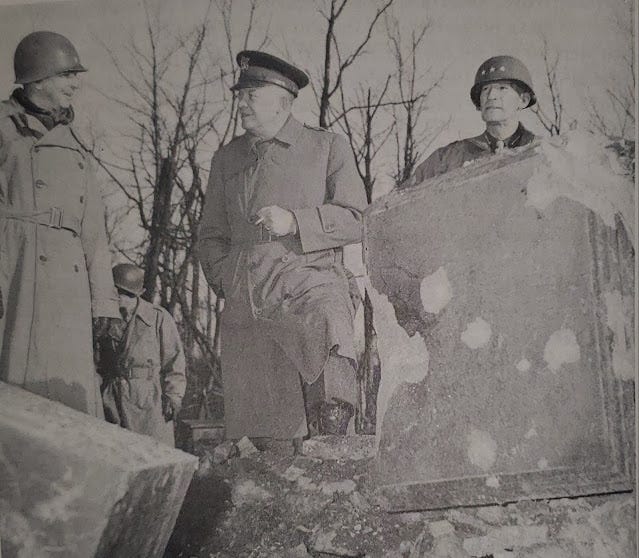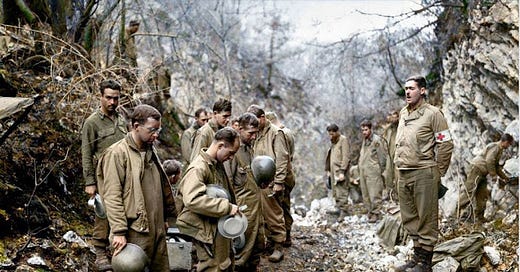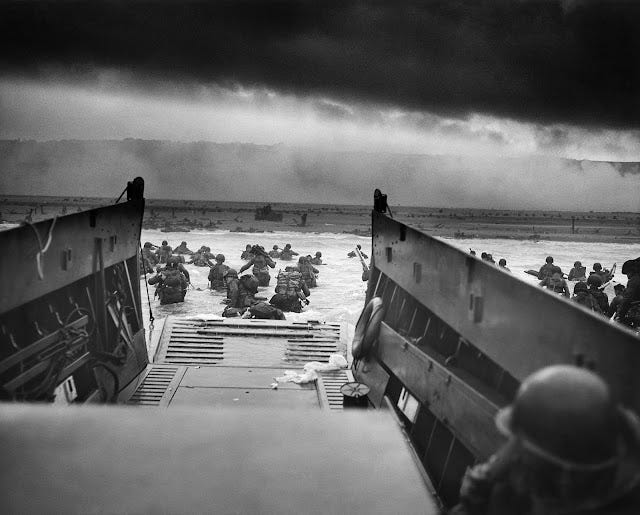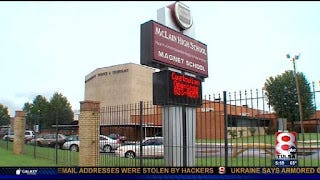Oklahoma's 45th Infantry (Thunderbirds)
This Memorial Day, I'm thankful for the contributions of our state's 45th Infantry.
Call to remembrance what acts our fathers did in their time; so shall ye receive great honour and an everlasting name - First Macabees 2:51

The soldiers I honor this Memorial Day are not in the regular army.
I honor our National Guard ‘citizen-soldiers.’
Specifically, I remember civilians who left their jobs in Oklahoma and became members of the famous 45th Army Reserve Infantry Brigade during World War II.
They were farmers, lawyers, teachers, and businessmen. In the above photograph, taken on Christmas Day 1943, south of Rome in a dry river bed, soldiers prayed before fighting the Axis powers so that “we can give humanity another chance.”
These soldiers were called Thunderbirds.
They helped the United States win World War II.
The soldier standing just to the right of Chaplain Harvey Floyd Bell has the Thunderbird patch on his left arm.
Chaplain Bell is identified by the traditional chaplain’s patch on his left arm, a red cross on white cloth.
Six months before the Christmas photo was taken, the Thunderbirds had invaded the island of Sicily. Using Sicily as their base, the Oklahoma boys stormed the Italian mainland, going ashore at the beaches of Salerno, Italy, on September 10, 1943 (see photo to the left).
The Thunderbirds then moved north, fighting their way toward Rome. It took several days to cross the Colore and Volturno rivers. After crossing the rivers, the soldiers were involved in fierce battles near the Italian city of Venafro. Majestic mountains surround this picturesque Italian city.
The fighting lasted 40 days and was known as “the days of mud, mules, and mountains.” Battling the cold, the wet weather, fatigue, and the tortuous mountain trails that were too steep and winding for jeeps to pass, the Thunderbirds faced extreme peril.
The Germans’ fanatical resistance and the introduction of the “screaming mimis” – fierce artillery fire that issued screeching screams as it flew toward the soldiers – it seemed impossible for the Oklahoma boys to take the town, and the mountains filled with German troops. Yet, against all odds, the Thunderbirds opened and secured a pathway to Rome.
The Oklahoma citizen-soldiers made the regular army marvel at their toughness and spirit.
General Raymond Stallings McLain (b. 1890 – d. 1954) prepared the Oklahoma National Guard to enter World War II.
Like the men he commanded, McLain served as a citizen-soldier in Oklahoma.
Born in Kentucky, McLain moved with his parents to the new state of Oklahoma in 1907. At seventeen, he worked as a clerk for an Oklahoma City abstract office and joined the newly formed Oklahoma National Guard.
Although McLain’s formal education ended in the sixth grade in Kentucky, he never stopped learning. McLain taught himself the banking and abstract business, eventually starting his own title and abstract company in Oklahoma City in his early twenties.
McLain fought in Europe as a captain, commanding a machine gun company.
Upon returning to Oklahoma City after World War I, McLain returned to the title business, later merging his small company with a larger one.
In 1919, at age 29, McLain became president of the merged company. He then began personally buying and selling real estate in north Oklahoma City and Edmond, a suburb north of OKC.
McLain was an excellent businessman and an even better soldier. He remained in the Oklahoma National Guard after World War I. He became an original member of the Oklahoma Thunderbirds 45th Infantry Division when it was formed in 1924. For the next twelve years, he served on weekends as a citizen-soldier. In 1937, McLain attended the Special Command and General Staff Class for Guard and Reserve officers at Fort Leavenworth, Kansas. Upon graduation, he became a Brigadier General of the Oklahoma National Guard.
General McLain was appointed Chief of Staff of the 45th National Guard Division (Thunderbirds). In the years preceding World War II, McLain meticulously drilled the troops. He demanded that all his subordinate officers train their men, knowing they might soon be in war.
Training could not be shortcutted or compromised. McClain is the reason the citizen-soldiers of Oklahoma became such excellent fighting men.
When World War II began, the Thunderbirds were ready. They fought with honor and discipline through the end of the war, eventually freeing the inmates at Dachau Concentration Camp.
McLain himself fought with distinction at Sicily, in Italy, and on the beaches of Normandy. The Army needed his leadership.
During the Battle of Normandy in August 1944, McLain briefly took command of the 90th Infantry Division, which had numerous command problems and needed a strong commander. He quickly transformed the 90th into a first-class fighting formation, just as he had done with the Oklahoma Thunderbirds. McLain led the 90th across France in the Allied advance from Paris to the Rhine, leading them to victory in numerous battles along the Western Front.
In October 1944, McLain assumed command of the XIX Corps and remained the commander for the rest of the war. General Raymond Stallings McLain was the only National Guardsman to command a corps during World War II combat.
McClain was the first guardsman to be given a battlefield promotion of two stars, and the first citizen soldier to command an army corps in battle since Dan Sickles raised a corps in New York and led it to Gettysburg. McLain’s XIX Corps defeated the Germans at Julich, improbably conquering the 600-year-old German fortress the Allied forces deemed near impregnable. General Dwight D. Eisenhower credited the Allied victory at Julich to General McLain’s aggressive tactics.

“General McLain in his person, elevated and gave great distinction to the term ‘citizen soldier, ” said General George C. Marshall in 1949.
The Oklahoma Hall of Fame inducted Raymond S. McLain in its class of 1945. McLain Magnet High School for Science and Technology in Tulsa, Oklahoma, also known as Tulsa McClain High School, took its name in honor of General McLain.
Fort Leavenworth inducted Raymond McLain into its Hall of Fame. To this day, General McClain remains the only National Guardsman so honored by Fort Leavenworth.
The prestigious LIEUTENANT GENERAL RAYMOND S. McLAIN MEDAL was established in 1999 and is awarded annually to a serving or former member of the United States National Guard who has contributed most to the advancement of the goal of the Association of the United States Army, the goal of a seamless and component-integrated U.S. Army.
For McLain’s distinguished service in the war, he was appointed a brigadier general in the Regular Army. Later, he became the comptroller of the United States Army and was appointed the army’s first statutory comptroller general. At the time of his death in 1954, he served on President Dwight D. Eisenhower‘s National Security Training Commission.
Raymond Stallings McLain died at Walter Reed General Hospital in Washington, D.C., on December 14, 1954, at 64.
Lieutenant General McLain’s decorations include Distinguished Service Cross with Oak leaf Cluster (Sicily, 1943 and France, 1944), the Army Distinguished Service Medal with Oak leaf Cluster (France, 1944 and Germany, 1945), Silver Star (Italy, 1943), Legion of Merit, Bronze Star with Oak leaf Cluster (Italy, 1944 and Germany, 1945), Mexican Border Service Medal, World War I Victory Medal with two battle clasps, American Defense Service Medal, American Campaign Medal, European-African-Middle Eastern Campaign Medal with one silver and three bronze service stars and Arrowhead device, World War II Victory Medal, Army of Occupation Medal, Chevalier of the Legion of Honor, French Croix de Guerre 1939-1945, Grand officer of the Order of Orange-Nassau with swords, Commander of the Order of Leopold II and Belgian Croix de Guerre.
AND NOW, THE REST OF THE STORY…
Robert McLain had an eye for real estate. While scouring far north Oklahoma City in the late 1920s, about three miles south of downtown Edmond, Oklahoma, McLain spotted an ideal property to buy for himself and a group of six investors, all fellow officers in the Oklahoma National Guard.
McLain described the large property as ‘a beautiful piece of wooded high ground.’
Keep reading with a 7-day free trial
Subscribe to Wade Burleson at Istoria to keep reading this post and get 7 days of free access to the full post archives.










